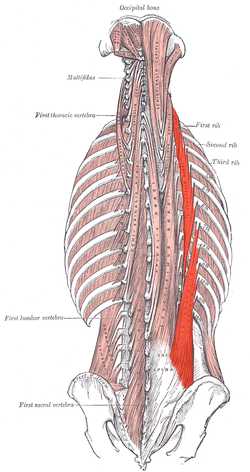Iliocostalis Lumborum
Original Editor - Oyemi Sillo
Lead Editors - Vidya Acharya, Oyemi Sillo, Kim Jackson, Abbey Wright, Lucinda hampton, Evan Thomas, WikiSysop and 127.0.0.1
Description[edit | edit source]
Iliocostalis Lumborum belongs to the lateral column of the Sacrospinalis group of muscles.[1] It is the most inferior and lateral of the erector spinae muscles.[2]
Origin[edit | edit source]
Anterior surface of a broad and thick tendon w attached to the medial crest of sacrum, spinous processes of the lumbar vertebrae, 11th and 12th thoracic vertebrae, posterior part of the medial lip of iliac crest, supra-spinous ligament and the lateral crest of sacrum[3].
Insertion[edit | edit source]
By tendons into inferior borders of the angles of the lower 6 or 7 ribs[3][4]
Nerve Supply[edit | edit source]
Dorsal rami of thoracic and lumbar spinal nerves (T7 to L3)[5]
Blood Supply[edit | edit source]
Dorsal branches of the lumbar arteries from the aorta. Dorsal branches of the lateral sacral artery from the internal iliac artery.[5]
Action[edit | edit source]
- acting bilaterally, extension and hyperextension of the spine
- acting unilaterally, laterally flexes the spine[4]
- assists as an accessory muscle of expiration, due to its insertion on the ribs[6].
Function[edit | edit source]
postural stabilization of vertebral column[5]
Clinical Relevance:[edit | edit source]
Assessment[3][edit | edit source]
Power[edit | edit source]
Position: Prone with hands clasped behind buttocks or head.
Fixation: Examiner must stabilize the legs firmly on the table.
Test: Trunk extension
Pressure: If performed with hands behind back no pressure is needed.
Weakness[edit | edit source]
Bilateral weakness of low back muscles results in a lumbar kyphosis and increased thoracic kyphosis.
Unilateral weakness results in lateral curvature with convexity towards the weak side.
Length[edit | edit source]
Bilateral contracture of low back muscles results in lordosis.
Unilateral contracture results in scoliosis with convexity to the opposite side.
Treatment[edit | edit source]
Strengthening[edit | edit source]
References[edit | edit source]
- ↑ Gray, Henry. Anatomy of the Human Body. Philadelphia: Lea & Febiger, 1918; Bartleby.com, 2000. www.bartleby.com/107/.
- ↑ Muscles That Influence the Spine; Barclay W. Bakkum, Gregory D. Cramer, in Clinical Anatomy of the Spine, Spinal Cord, and Ans (Third Edition), 2014 https://www.sciencedirect.com/topics/neuroscience/iliocostalis
- ↑ 3.0 3.1 3.2 Muscle Testing and Function;4th Edition; Kendall, McCreary, Provance; Page No.138.
- ↑ 4.0 4.1 http://www.wheelessonline.com/ortho/iliocostalis_lumborum_1
- ↑ 5.0 5.1 5.2 http://www.anatomyexpert.com/app/structure/5243/
- ↑ Muscles Testing and Function;4th Edition; Kendall, McCreary, Provance; Accessory Muscles of Respiration, Page No.330.







